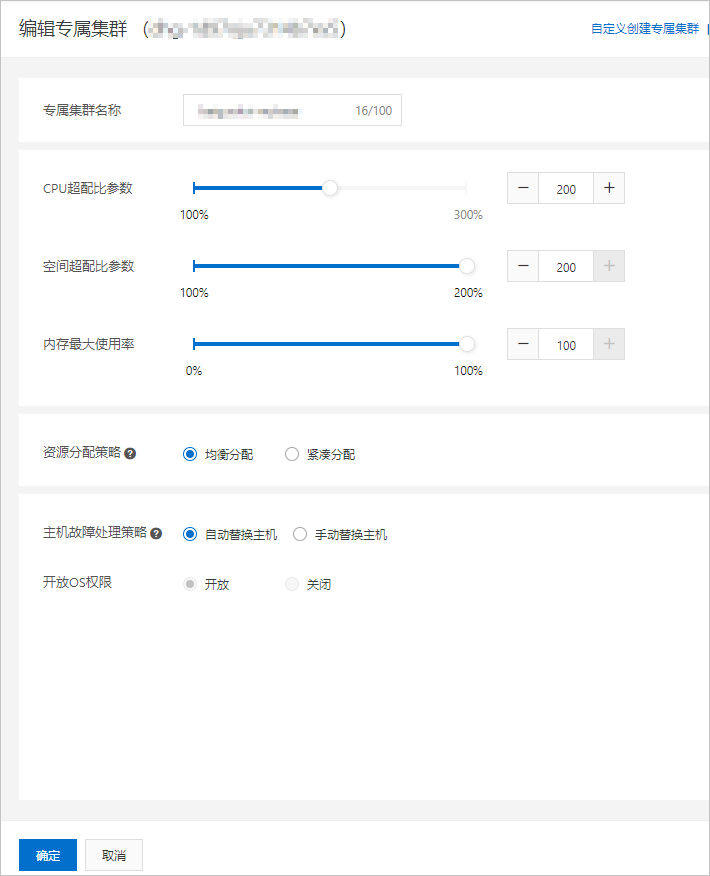建立專屬叢集MyBase後,您可以查看、修改、刪除專屬叢集。
背景資訊
關於專屬叢集MyBase的更多介紹,請參見什麼是雲資料庫專屬叢集MyBase。
查看叢集資訊
登入雲資料庫專屬叢集控制台。
在頁面左上方,選擇目標地區。
在叢集列表頁,查看專屬叢集資訊,或者將資訊下載到本地。
預設展示專屬叢集ID、專用網路、主機數等資訊,您可以在右側單擊
 ,設定列表中展示的資訊。
,設定列表中展示的資訊。
您可以單擊右側
 ,下載叢集資訊到本地查看。
,下載叢集資訊到本地查看。
選擇目的地組群,單擊操作列中的詳情。
在專屬叢集資訊頁面,查看各項參數。
參數
說明
專屬叢集ID
專屬叢集ID。
專屬叢集名稱
專屬叢集的名稱。
引擎
專屬叢集的引擎。
架構系列
僅引擎選擇MySQL時出現此參數,預設為高可用。
专有网络
專屬叢集歸屬的Virtual Private Cloud。
主機數(台)
專屬叢集內的主機數。
執行個體數(個)
專屬叢集內的執行個體數。
主機故障處理策略
主機故障時,系統的處理策略:
- 自動替換主機:系統會自動替換故障主機。 說明
- 如果故障主機是雲端硬碟主機,雲端硬碟會自動遷移計算資源以自動替換主機。
- 如果故障主機是非雲端硬碟主機,則系統會先將故障主機上的執行個體遷移走,然後自動替換故障主機。
- 手動替換主機:使用者需要手動替換故障主機。
開放OS許可權
主機是否開放OS許可權。
資源分派策略
專屬叢集資源調度的預設分配策略:
- 均衡分配:最大化追求更穩定的系統資料表現,優先從未分配資源或已指派資源較少的主機中分配資源。
- 緊湊分配:最大化追求更充分的資源使用率,優先從建立時間較早且已指派資源較多的主機中分配資源。
CPU超配比
專屬叢集的CPU超配比。例如CPU超配比為200%,即所有執行個體的CPU資源之和可以是實際CPU資源的2倍,可以最大化使用CPU資源。
空間超配比
專屬叢集的空間超配比。例如空間超配比為200%,即所有執行個體的空間資源之和可以是實際空間資源的2倍,可以最大化使用空間資源。
記憶體最大使用率
專屬叢集中每台主機的記憶體最大使用率。
建立時間
專屬叢集的建立時間。
- 自動替換主機:系統會自動替換故障主機。
修改叢集
登入雲資料庫專屬叢集控制台。
在頁面左上方,選擇目標地區。
在叢集列表頁,單擊目標專屬叢集操作列的修改。
設定以下參數。

參數
說明
專屬叢集名稱
自訂專屬叢集名稱,方便區分。
CPU超配比參數
設定專屬叢集的CPU超配比。
說明不同引擎該參數的取值範圍與預設值有所差異,請以控制台頁面展示為準。
空間超配比參數
設定專屬叢集的空間超配比,僅MySQl支援修改專屬叢集的空間超配比。
說明不同引擎該參數的取值範圍與預設值有所差異,請以控制台頁面展示為準。
記憶體最大使用率
設定專屬叢集中每台主機的記憶體最大使用率。
說明不同引擎該參數的取值範圍與預設值有所差異,請以控制台頁面展示為準。
資源分派策略
設定專屬叢集資源調度的預設分配策略:
- 均衡分配:最大化追求更穩定的系統資料表現,優先從未分配資源或已指派資源較少的主機中分配資源。
- 緊湊分配:最大化追求更充分的資源使用率,優先從建立時間較早且已指派資源較多的主機中分配資源。
主機故障處理策略
設定主機故障時系統的處理策略:
- 自動替換主機:系統會自動替換故障主機。 說明
- 如果故障主機是雲端硬碟主機,雲端硬碟會自動遷移計算資源以自動替換主機。
- 如果故障主機是非雲端硬碟主機,則系統會先將故障主機上的執行個體遷移走,然後自動替換故障主機。
- 手動替換主機:使用者需要手動替換故障主機。
開放OS許可權
專屬叢集MySQL、SQL Server、PostgreSQL引擎的主機提供作業系統(OS)許可權,您可以登入主機進行上傳、下載、安裝軟體等操作。
重要開放OS使用權限設定後無法修改。
單擊確定。
刪除專屬叢集MyBase
登入雲資料庫專屬叢集控制台。
在頁面左上方,選擇目標地區。
在專屬叢集列表頁,單擊目標專屬叢集操作列的刪除。

在彈出的對話方塊中,單擊確定。